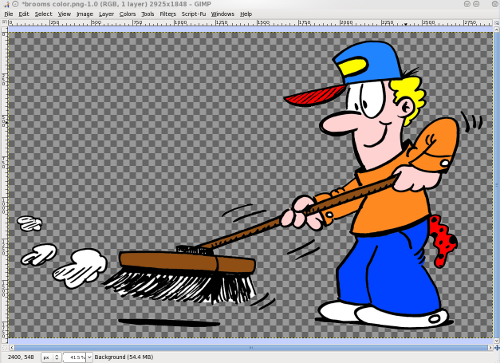

Since it’s so fast, it’s often worth giving it a try just to see if the results are usable. The only real control you have over the final selection comes from adjusting the Threshold setting in the tool options, which determines the size of the color selection range. Well, for the most part, it’s very helpful when used on the right image – but it can also run into trouble fairly easily. Setting the Threshold level too low can leave out unnoticed background colors and require some additional help to create a good selection, as you can see in the bottom left of the image and along the green leaf edges This is GIMP’s name for a “magic wand” type of selection tool that automatically selects all pixels within a specific color range of the first color your click on. The fastest way to create a selection around your subject is to use the Fuzzy Select Tool. Holding down the Shift key adds to your existing selection, while the Ctrl key subtracts. You can also combine them to get the results you need without doing everything by hand. Selecting single strands of hair may come to haunt your dreams.įortunately, there are some helpful tools that can make the process simpler and far less stress-inducing. It’s simple enough if you’re working on a photo of a plain plastic cube, but as soon as your shapes get more complex, the time investment grows rapidly. This part of the process is by far the most time-consuming and fiddly. Step 2: Isolate Your Subject With A Selection If the option is unavailable, your image probably already has an alpha channel.Īlpha channels are created automatically once you add multiple layers to an image because transparency is an essential element of how the layer compositing works, so that may have taken care of things for you already. The simplest way is to open the Layers menu from the menubar, select the Transparency submenu, and click Add Alpha Channel. There are two ways to add an alpha channel to your image. Alpha channels are also just grayscale images, but instead of representing red, green, or blue, any white pixels it contains are treated as transparent. In order to add transparency to our image, we need to make sure it contains a fourth channel called an alpha channel. Each channel is just a grayscale image, but depending on which channel it represents, white pixels display as the channel color and are combined to make a normal image. Typical computer images are made up of three color channels: a Red channel, a Green channel, and a Blue channel. Step 1: Adding Transparency with an Alpha Channel Step 4: Export Your Image as a PNG File.Step 3: Remove or Hide Unwanted Background Areas.

Step 2: Isolate Your Subject With A Selection.Step 1: Adding Transparency with an Alpha Channel.

One interesting feature of PNG files is the ability to create transparency in the image, particularly a transparent background. PNG files are a bit larger than other file types, so exercise caution when adding them to a web page. If you are having trouble opening PNG files, use our PNG to JPG, PNG to WebP, or PNG to BMP converters.Īlternative programs such as GIMP or Adobe Photoshop are useful for opening and editing PNG files. PNG files are also easily viewable on all web browsers. Generally, PNG files will open in your operating system’s default image viewer. The benefits of using PNG are Plus, PNG is an open format that uses lossless compression. PNG also supports animations with better transparency (try our GIF to APNG). PNG images can have RGB or RGBA colors and support transparency, which makes them perfect for use in icons, or graphic designs.
Animating in gimp transparent background portable#
Portable Network Graphics (PNG) is a raster-based file type that compresses images for portability.


 0 kommentar(er)
0 kommentar(er)
